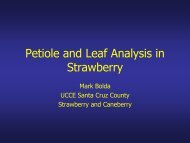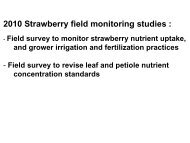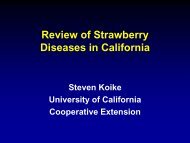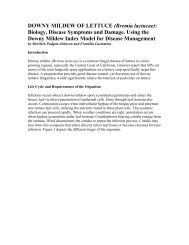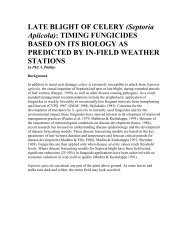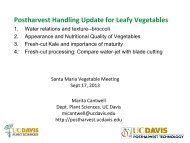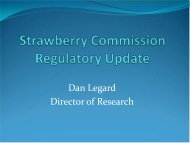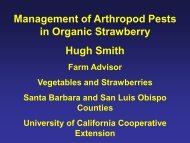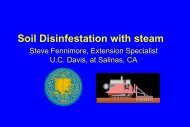Dara-Managing Vegetable Pests - Santa Barbara County ...
Dara-Managing Vegetable Pests - Santa Barbara County ...
Dara-Managing Vegetable Pests - Santa Barbara County ...
You also want an ePaper? Increase the reach of your titles
YUMPU automatically turns print PDFs into web optimized ePapers that Google loves.
<strong>Managing</strong> thrips on lettuce, aphids on broccoli, and<br />
the new invasive pest Bagrada bug on cole crops<br />
Surendra <strong>Dara</strong><br />
Strawberry and <strong>Vegetable</strong> Crops Advisor and Affiliated IPM Advisor<br />
University of California Cooperative Extension<br />
<strong>Santa</strong> <strong>Barbara</strong> and San Luis Obispo Counties<br />
skdara@ucdavis.edu<br />
@calstrawberries @calveggies<br />
strawberriesvegetables<br />
ucanr.org/strawberries-vegetables and ucanr.org/pestnews
Western flower thrips Frankliniella occidentalis<br />
Second instar larva<br />
Adult morphs<br />
Feeding damage<br />
Necrotic spots by<br />
tomato spotted wilt virus
Lettuce-experimental design<br />
Treatments<br />
1. Untreated control<br />
2. Assail 30 SC (acetamiprid) 4 oz<br />
+ DyneAmic (NIS) 0.1% v/v<br />
3. Radiant SC (spinetoram) 8 fl oz<br />
+ Dyne Amic 0.25%<br />
4. BotaniGard 22 WP (Beauveria bassiana) 2 lb + DyneAmic 0.125%<br />
5. Torac 15 EC (tolfenpyrad) 21 fl oz + DyneAmic 0.25%<br />
6. Torac 15EC 21 fl oz + Lannate SP 0.75 lb + DyneAmic 0.25%<br />
7. NNI-1171 21 fl oz (new ai) + DyneAmic 0.25%<br />
Spraying<br />
Plot size<br />
50* gal/acre at 70 psi with flat fan nozzle<br />
(*100 gpa for BotaniGard)<br />
5 rows, 5.33’ wide 10’ long bed replicated 4 times<br />
Planted on April 6, 2012<br />
Treated on May 16 and 24 and June 6, 2012
5/15/2012<br />
5/16/2012<br />
5/17/2012<br />
5/18/2012<br />
5/19/2012<br />
5/20/2012<br />
5/21/2012<br />
5/22/2012<br />
5/23/2012<br />
5/24/2012<br />
5/25/2012<br />
5/26/2012<br />
5/27/2012<br />
5/28/2012<br />
5/29/2012<br />
5/30/2012<br />
5/31/2012<br />
6/1/2012<br />
6/2/2012<br />
6/3/2012<br />
6/4/2012<br />
6/5/2012<br />
6/6/2012<br />
6/7/2012<br />
6/8/2012<br />
6/9/2012<br />
6/10/2012<br />
6/11/2012<br />
6/12/2012<br />
6/13/2012<br />
Number of thrips/plant<br />
Thrips populations during the study<br />
5<br />
Untreated Acetamiprid Spinetoram B. bassiana<br />
Tolfenpyrad Tolfen.+Metho. NNI-1171<br />
4<br />
3<br />
2<br />
1<br />
0
Number of thrips/plant<br />
Thrips after each spray application<br />
Pre-treatment After I Spray After II Spray After III Spray<br />
3<br />
a<br />
a<br />
ab<br />
2<br />
ab<br />
abc<br />
b<br />
abc<br />
ab<br />
bc<br />
1<br />
c<br />
b<br />
c<br />
b<br />
b<br />
0<br />
Untreated Acetamiprid Spinetoram B. bassiana Tolfenpyrad Tolfen.+Metho. NNI-1171
Number of thrips/plant<br />
Thrips before and after the spray applications<br />
3<br />
Pre-treatment<br />
Post-treatment<br />
a<br />
a<br />
2<br />
ab<br />
bc<br />
bc<br />
1<br />
c<br />
c<br />
0<br />
Untreated Acetamiprid Spinetoram B. bassiana Tolfenpyrad Tolfen.+Metho. NNI-1171
Percent change after treatment<br />
Percent change in thrips after treatment<br />
300<br />
250<br />
200<br />
150<br />
100<br />
50<br />
0<br />
-50<br />
-100<br />
Untreated Acetamiprid Spinetoram B. bassiana Tolfenpyrad Tolfen.+Metho. NNI-1171
Conclusion<br />
• Thrips numbers were significantly lower in chemical<br />
treatments compared to untreated control.<br />
• Tolfenpyrad alone and with methomyl provided<br />
good control.<br />
• Microbial control also has a potential for thrips<br />
management.
Cabbage aphid and green peach aphid<br />
Cabbage aphid, Brevicoryne brassicae<br />
Green peach aphid, Myzus persicae
Broccoli-experimental design<br />
Treatments<br />
1. Untreated control<br />
2. Assail 30 SC (acetamiprid) 4 oz<br />
+ DyneAmic (NIS) 0.1% v/v<br />
3. BotaniGard 22 WP (Beauveria bassiana) 2 lb<br />
+ DyneAmic 0.125%<br />
4. Torac 15 EC (tolfenpyrad) 21 fl oz<br />
+ DyneAmic 0.25%<br />
5. Pyrifluquinazon 3.2 fl oz + DyneAmic 0.25%<br />
6. NNI-1171 21 fl oz (new ai) + DyneAmic 0.25%<br />
7. Closer (sulfoxaflor) 1.5 fl oz + DyneAmic 0.25%<br />
8. Closer 2.0 fl oz + DyneAmic 0.25%<br />
Spraying<br />
Plot size<br />
50* gal/acre at 70 psi with flat fan nozzle (*100 gpa for BotaniGard)<br />
5 rows, 5.33’ wide 20’ long bed replicated 4 times<br />
Planted on July 31, 2012<br />
Treated on September 5 and 25, 2012
Number of aphids/plant<br />
Aphid populations during the study<br />
6<br />
Untreated Acetamiprid B. bassiana Tolfenpyrad<br />
Pyrifluquinazon NNI-1171 Sulfoxaflor 1.5 Sulfoxaflor 2.0<br />
5<br />
4<br />
3<br />
2<br />
1<br />
0<br />
Pre-treatment I-3DAT I-7DAT I-13DAT II-3DAT II-7DAT II-12DAT
Number of cabbage aphids/plant<br />
Cabbage aphids<br />
4<br />
Untreated Acetamiprid B. bassiana Tolfenpyrad<br />
Pyrifluquinazon NNI-1171 Sulfoxaflor 1.5 Sulfoxaflor 2.0<br />
3<br />
2<br />
1<br />
0<br />
Pre-treatment I-3DAT I-7DAT I-13DAT II-3DAT II-7DAT II-12DAT
Number of green peach aphids/plant<br />
Green peach aphids<br />
3<br />
Untreated Acetamiprid B. bassiana Tolfenpyrad<br />
Pyrifluquinazon NNI-1171 Sulfoxaflor 1.5 Sulfoxaflor 2.0<br />
2<br />
1<br />
0<br />
Pre-treatment I-3DAT I-7DAT I-13DAT II-3DAT II-7DAT II-12DAT
Number of aphids/plant<br />
Aphids after each spray application<br />
5<br />
Pre-treatment After I Application After II Application<br />
4<br />
a<br />
3<br />
ab<br />
a<br />
2<br />
1<br />
b<br />
ab<br />
ab<br />
ab<br />
ab<br />
b<br />
ab<br />
b<br />
ab<br />
b<br />
ab<br />
b<br />
0<br />
Untreated Acetamiprid B. bassiana Tolfenpyrad Pyrifluquinazon NNI-1171 Sulfoxaflor 1.5 Sulfoxaflor 2.0<br />
b
Number of aphids/plant<br />
Aphids before and after spray applications<br />
5<br />
Pre-treatment<br />
Post-treatment<br />
4<br />
3<br />
a<br />
ab<br />
2<br />
ab<br />
1<br />
ab<br />
ab<br />
ab<br />
b<br />
b<br />
0<br />
Untreated Acetamiprid B. bassiana Tolfenpyrad Pyrifluquinazon NNI-1171 Sulfoxaflor 1.5 Sulfoxaflor 2.0
Percent change after treatment<br />
Percent change in aphids after treatment<br />
0<br />
-20<br />
-40<br />
-60<br />
-80<br />
-100
Number of cabbage aphids/plant<br />
Cabbage aphids before and after spray applications<br />
4<br />
Pre-treatment<br />
Post-treatment<br />
3<br />
2<br />
a<br />
ab<br />
1<br />
abc<br />
abc<br />
0<br />
abc<br />
c<br />
bc<br />
c<br />
Untreated Acetamiprid B. bassiana Tolfenpyrad Pyrifluquinazon NNI-1171 Sulfoxaflor 1.5 Sulfoxaflor 2.0
Percent change after treatment<br />
Percent change in cabbage aphids after treatment<br />
60<br />
40<br />
20<br />
0<br />
-20<br />
-40<br />
-60<br />
-80<br />
-100
Number of green peach aphids/plant<br />
Green peach aphids before and after spray applications<br />
3<br />
Pre-treatment<br />
Post-treatment<br />
2<br />
a<br />
ab<br />
1<br />
ab<br />
ab<br />
ab<br />
ab<br />
b<br />
ab<br />
0<br />
Untreated Acetamiprid B. bassiana Tolfenpyrad Pyrifluquinazon NNI-1171 Sulfoxaflor 1.5 Sulfoxaflor 2.0
Percent change after treatment<br />
Percent change in green peach aphids after treatment<br />
40<br />
20<br />
0<br />
-20<br />
-40<br />
-60<br />
-80<br />
-100
Conclusions<br />
• Cabbage and green peach aphids responded<br />
differently to treatments.<br />
• Sulfoxaflor provided good control for both aphid<br />
species.<br />
• B. bassiana provided good control of green peach<br />
aphids which was similar to some chemical<br />
treatments
Bagrada bug, Bagrada hilaris<br />
Order: Hemiptera<br />
Family: Pentatomidae (Stink bugs)<br />
Origin: Africa<br />
Distribution: Asia and Europe and now in Arizona and<br />
California<br />
Host plants: Mainly crucifers. Also infests malvaceous,<br />
leguminoseous, cucurbits, and graminaceous plants<br />
London rocket, wild mustards, pepperweed, and others
Bagrada bug-Distribution<br />
In Los Angeles <strong>County</strong> in 2008.<br />
California: Kern, Imperial, Los Angeles,<br />
Monterey, Orange, Riverside, San Diego,<br />
<strong>Santa</strong> <strong>Barbara</strong>, San Luis Obispo, and<br />
Ventura Counties<br />
Arizona: Yuma, La Paz, Maricopa, and Pinal Counties<br />
New Mexico: Luna, Socorro, Valencia, and <strong>Santa</strong> Fe<br />
Counties<br />
Nevada, Utah, and Texas
Bagrada bug-Host range<br />
Brassicaceae: Alyssum, arugula, broccoli, cabbage,<br />
cauliflower, collards, cress, kale, radish, rutabaga, turnips, etc.<br />
Cucurbitaceae: Cantaloupes and watermelons<br />
Graminaceae: Corn, millets, and wheat<br />
Leguminaceae: Various legumes<br />
Malvaceae: Cotton and okra<br />
Rosaeae: Strawberry<br />
Solanaceae: Potato
Bagrada bug-Biology<br />
Eggs<br />
• Barrel-shaped, laid singly or in small groups on plant<br />
surface or in soil<br />
• Each female lays up to 95 eggs<br />
• Whitish and turn orange with age<br />
• Hatch in 3-6 days<br />
Ta-I Huang, Univ Arizona<br />
Eric Natwick, UCCE
Bagrada bug-Biology<br />
Nymphs<br />
• There are five nymphal instars<br />
• Newly emerged nymphs are reddish orange and develop<br />
white and black markings with time<br />
• Nymphal stage lasts for 2-3 weeks<br />
Ta-I Huang,<br />
Univ Arizona
Bagrada bug-Biology<br />
Adults<br />
• They are 1/5-1/3” long and 1/8-1/6” wide<br />
• Black with orange and white markings<br />
• Females are larger than males
Bagrada bug-Biology<br />
Harlequin bug vs. Bagrada bug<br />
projectnoah.org<br />
nathistoc.bio.uci.edu
Bagrada bug-Damage<br />
Suck the plant juices with their needle-like mouthparts.<br />
Stippling with necrotic spots, stunted growth, loss of<br />
apical dominance, formation of multiple heads and<br />
plant death.
Bagrada bug-Chemical control<br />
2012 Small plot broccoli trials at Yuma Ag Center (John Palumbo and Ta-I Huang)<br />
1 st application Mean Number of Adults/20 Plants<br />
Treatment<br />
1-Day After<br />
Treatment<br />
3-Days After<br />
Treatment<br />
5-Days After<br />
Treatment<br />
Bifenthrin 0.0 b 0.5 d 2.3 b<br />
Methomyl 1.8 b 2.5 bcd 4.0 ab<br />
Chlorpyrifos 1.5 b 1.5 cd 3.0 ab<br />
Clothianidin 0.5 b 4.0 ab 5.0 a<br />
Dinotefuran 0.5 b 2.0 bcd 6.8 a<br />
Acephate 0.5 b 3.5 abc 4.0 ab<br />
Untreated control 7.3 a 5.8 a 6.8 a<br />
Martin, Palumbo, <strong>Dara</strong>, and Natwick 2013
Bagrada bug-Control<br />
2012 Small plot broccoli trials at Yuma Ag Center (John Palumbo and Ta-I Huang)<br />
2 nd application Mean Number of Adults/20 Plants<br />
Treatment<br />
1-Day After<br />
Treatment<br />
3-Days After<br />
Treatment<br />
5-Days After<br />
Treatment<br />
Bifenthrin 0.0 b 1.3 bc 1.5 a<br />
Methomyl 0.0 b 1.0 c 4.0 a<br />
Chlorpyrifos 0.8 b 5.0 ab 4.0 a<br />
Clothianidin 0.8 b 4.3 abc 5.5 a<br />
Dinotefuran 0.3 b 1.3 bc 4.0 a<br />
Acephate 0.8 b 1.5 bc 5.5 a<br />
Untreated control 5.0 a 6.8 a 6.5 a<br />
Martin, Palumbo, <strong>Dara</strong>, and Natwick 2013
Bagrada bug-Non-chemical control<br />
Active Ingredient<br />
Beauveria bassiana<br />
strain GHA<br />
Metarhizium brunneum<br />
strain F 52<br />
Isaria fumosorosea<br />
strain FE9901<br />
Chromobacterium subtsugae<br />
strain PRAA4-1<br />
Pyrethrins + potassium salts of<br />
fatty acids<br />
Product*<br />
Mycotrol O®<br />
Met 52 ®<br />
NoFly ®<br />
Grandevo®<br />
Safer Yard & Garden<br />
Insect Killer®<br />
Application<br />
Rate<br />
1 qrt/100 gal<br />
1 qrt/100 gal<br />
28 oz/100 gal<br />
3 lb/100 gal<br />
Ready-to-use<br />
Essential oil blend Rid-Bugs® 60 ml/gal<br />
*Verify label status before using any of these materials<br />
Martin, Palumbo, <strong>Dara</strong>, and Natwick 2013
Bagrada bug-Non-chemical control<br />
B. hilaris on treated broccoli Fungus emerging from surfacesterilized<br />
cadavers<br />
Martin, Palumbo, <strong>Dara</strong>, and Natwick 2013
Bagrada bug-Non-chemical control<br />
B. hilaris killed by B. bassiana B. hilaris killed by M. brunneum<br />
B. hilaris killed by I. fumosorosea<br />
Martin, Palumbo, <strong>Dara</strong>, and Natwick 2013
Percent infection/mortality<br />
Bagrada bug-Non-chemical control<br />
100<br />
80<br />
60<br />
40<br />
20<br />
0<br />
Untreated Mycotrol-O Met 52 NoFly Grandevo Safer Rid-Bugs<br />
B. bassiana<br />
M. brunneum I. fumosorosea C. subtsugae Pyrethrins +<br />
Insecticidal soap<br />
Essential oils<br />
Martin, Palumbo, <strong>Dara</strong>, and Natwick 2013
Bagrada bug-Cultural control<br />
• Consider removing weed hosts<br />
• Ensure transplants and other nursery materials are<br />
free of Bagrada bugs before planting<br />
• Cultivate to destroy bugs and eggs in the soil; research<br />
on effectiveness has not been completed<br />
• Exclusion: row covers may prevent damage but<br />
research on effectiveness has not been done<br />
• Shred and disc crop immediately after harvest<br />
• Rotate to a non-host crop<br />
Martin, Palumbo, <strong>Dara</strong>, and Natwick 2013
Bagrada bug-Monitoring<br />
• Look for Bagrada bug the morning after transplanting when the sprinklers<br />
are off.<br />
• For direct-seeded cole crops, look for bugs as soon as seedlings emerge.<br />
• Continue monitoring weekly until the 5- to 6-leaf stage in direct seeded and<br />
transplanted crops.<br />
• After the 5- to 6-leaf stage, laboratory and field research show most plants<br />
can tolerate Bagrada bug feeding without significant injury or yield loss.<br />
• Monitor mid-morning to late afternoon (10 a.m.–4 p.m.) when temperatures<br />
are near or above 86°F<br />
• Look for fresh feeding on cotyledons and young leaves; look for wilted<br />
seedlings<br />
• Look for bugs on plants underneath cotyledons and leaves, on the stem at<br />
the soil surface, in cracks in the soil, and under dirt clods<br />
• After insecticide applications look carefully on the soil for dead bugs (bugs<br />
blend in with the soil and also play dead when disturbed)<br />
Martin, Palumbo, <strong>Dara</strong>, and Natwick 2013
Bagrada bug-Thresholds<br />
• Prevent adults from feeding on plant terminals and small<br />
cotyledons in order to establish a quality stand.<br />
• One adult per ten-foot row of seedlings or transplants<br />
causes stand loss or unacceptable plant damage.<br />
• For transplants, chemigate at the first sign of damage or<br />
when adults are found.<br />
• For direct-seeded crops, chemigate when seedlings first<br />
emerge.<br />
• When stands are established, apply an insecticide when<br />
bugs or fresh damage is readily observed.<br />
Martin, Palumbo, <strong>Dara</strong>, and Natwick 2013
Bagrada bug-Video<br />
http://www.youtube.com/watch?v=gSj3AZoJIRM
Acknowledgments<br />
Growers<br />
Frank Costa<br />
San Ysidro Farms<br />
Technicians<br />
Thomas Crottogini<br />
Pedro Villela<br />
Pesticide Industry<br />
Curt Engle<br />
Pedro Hernandez<br />
Jesse Richardson<br />
Pest infestations



